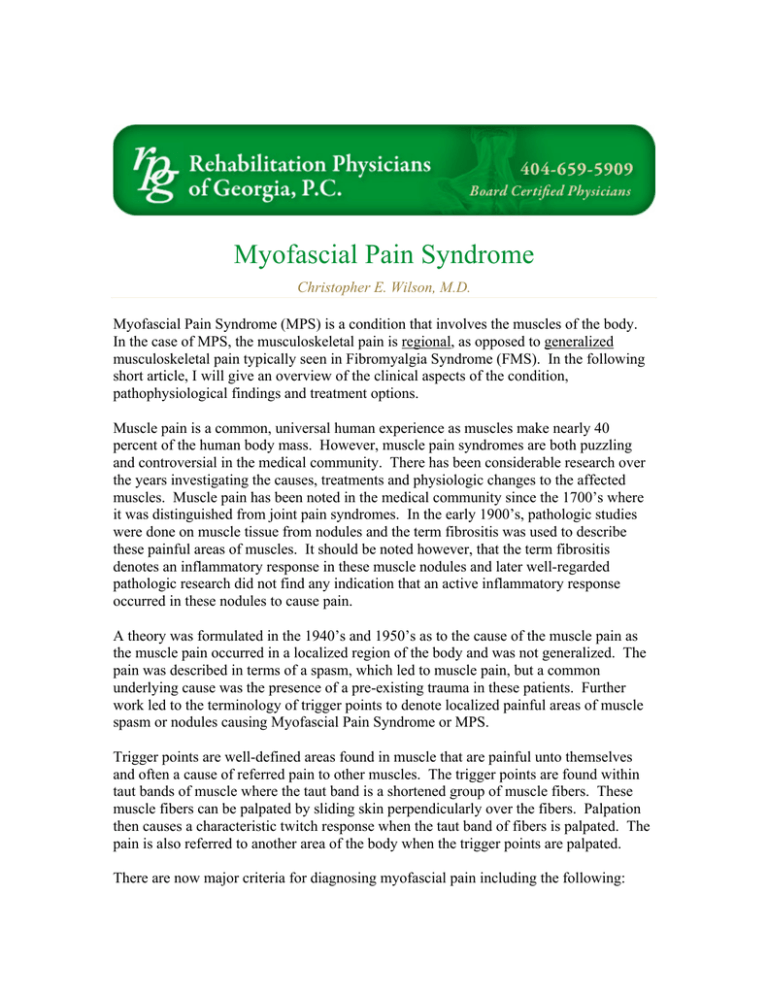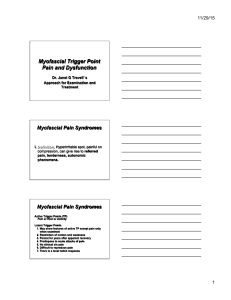Myofascial Pain Syndrome - Physician Pain Specialists
advertisement

Myofascial Pain Syndrome Christopher E. Wilson, M.D. Myofascial Pain Syndrome (MPS) is a condition that involves the muscles of the body. In the case of MPS, the musculoskeletal pain is regional, as opposed to generalized musculoskeletal pain typically seen in Fibromyalgia Syndrome (FMS). In the following short article, I will give an overview of the clinical aspects of the condition, pathophysiological findings and treatment options. Muscle pain is a common, universal human experience as muscles make nearly 40 percent of the human body mass. However, muscle pain syndromes are both puzzling and controversial in the medical community. There has been considerable research over the years investigating the causes, treatments and physiologic changes to the affected muscles. Muscle pain has been noted in the medical community since the 1700’s where it was distinguished from joint pain syndromes. In the early 1900’s, pathologic studies were done on muscle tissue from nodules and the term fibrositis was used to describe these painful areas of muscles. It should be noted however, that the term fibrositis denotes an inflammatory response in these muscle nodules and later well-regarded pathologic research did not find any indication that an active inflammatory response occurred in these nodules to cause pain. A theory was formulated in the 1940’s and 1950’s as to the cause of the muscle pain as the muscle pain occurred in a localized region of the body and was not generalized. The pain was described in terms of a spasm, which led to muscle pain, but a common underlying cause was the presence of a pre-existing trauma in these patients. Further work led to the terminology of trigger points to denote localized painful areas of muscle spasm or nodules causing Myofascial Pain Syndrome or MPS. Trigger points are well-defined areas found in muscle that are painful unto themselves and often a cause of referred pain to other muscles. The trigger points are found within taut bands of muscle where the taut band is a shortened group of muscle fibers. These muscle fibers can be palpated by sliding skin perpendicularly over the fibers. Palpation then causes a characteristic twitch response when the taut band of fibers is palpated. The pain is also referred to another area of the body when the trigger points are palpated. There are now major criteria for diagnosing myofascial pain including the following: 1. 2. 3. 4. 5. Regional pain Referred pain A taut band A tender point in the taut band Restricted range of motion There are also several minor criteria that can be used to diagnose this condition. Those criteria are: 1. Pain complaint reproduced by pressure on the tender spot 2. A local twitch response 3. Relief of pain with injection or stretching As to the pathophysiology of this condition, research redefined Myofascial Pain Syndrome through the use of electromyography or EMG. EMG failed to find the spasm in the involved muscle that was previously postulated. It was found that a sequence of factors occur in the localized muscles leading to pain that involved an acute muscle strain in a regional area with localized tissue damage in an area of muscle. The damage leads to tears in the sarcoplasmic reticulum, which caused free calcium ions to result in sustained muscle contraction. This sustained contraction causes the muscle-based pain. Treatment options include the use of localized treatments or injections of the trigger points. The uses of localized treatments involve applying cold sprays, directly to the trigger points. Stretching of the affected muscles, massage and myofascial release techniques via manual therapy can be done and is often very effective. In many cases, injection of the trigger points can provide activate relief that usually provides much quicker relief than the use of the local treatments alone, which may not show effects for several days. It has been found that just placing a dry needle or saline solution without using an injectate is sometimes enough to decrease pain, but most experts inject a local anesthetic or anesthetic with combination of a corticosteroid. It should be noted however that the use of a corticosteroid may not be beneficial as prior research suggests that there is not an inflammatory response in the trigger points that cause myofascial pain. When considering treatment with medicines, analgesia can be obtained with NSAID’s, especially those with excellent analgesia characteristics such as Celebrex (Celecoxib), acetaminophen containing medications and newer agents such as Ultram (Tramadol). The goal is to avoid opioiod narcotic medications. Also, I have found that most patients benefit from use of a muscle relaxant. For those patients suffering from Myofascial Pain Syndrome the pain is very real. Treatment plans are usually multi-factorial and can only begin after a complete and thorough diagnosis. The goal is to help patients manage their pain and return to an optimum level of function. The author, Christopher E. Wilson, M.D., is board-certified in Physical Medicine and Rehabilitation and specialzest in the treatment of musculoskeletal pain. He is also a pharmacist. Dr. Wilson is a member of Rehabilitation Physicians of Georgia, P.C. (RPG). He can be reached at 404-659-5909 or on the RPG website at www.attackback.com.





